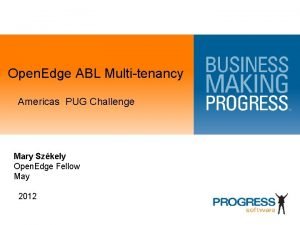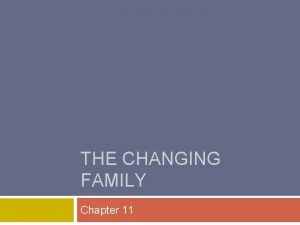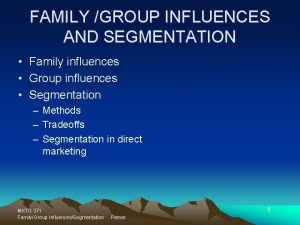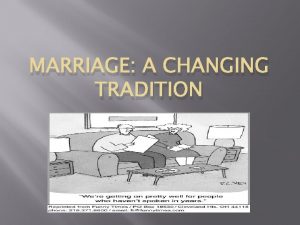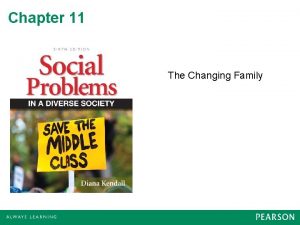Americas Changing Family Group 1 A 1031152 W

















- Slides: 17

America’s Changing Family Group 1 A 1031152 林珈儀 W 1041105 金孝政

INDEX 1 Text Summary Current American Family 3 Cost of Marriage in Different Countries Cohabitation: Increasing norm 5 2 4 Conclusion References 6

1 Text Summary 1. The traditional American family- comprised of a husband, wife, and children- is in decline. According to Frank Hobbs, No. 1 Living Alone (26%) No. 2 Householder + Spouse + Child (22%) No. 3 Householder + Spouse + No child (in 2000) Intro.

1 Text Summary Body 2. Causes of this demographic shift 1 st: Growing Economic Power of Women 2 nd: Marriage Tax 3. Non-traditional family structures used to be frowned on, because children of single or cohabitating parents were believed to be unsuccessful. 4. However, with cohabitation increasingly becoming the norm, some people argue that one can raise children successfully in different types of living structures.

1 Text Summary Conclusion 5. Since there will be further decline in the number of traditional households, the government should extend tax and welfare benefits to single people and unmarried couples.

2 Current American Family 1. More Americans are putting off marriage and having children. People married (age: 18 -32) From 1960 to 2013 65% Women having children (age: 18 -32) From 1960 to 2011 40% 26% 22%

2 Current American Family 2. More Americans are having less children. 3. 7名 1960年 2. 1名 1. 9名 (Replacement Fertility level) 2014年

2 Current American Family 3. LGBT couples & more blended American families. 37% LGBT Having children (average) 44% 41% People(18 -29歲) Unmarried Having Woman Having Step sibling Birth (2011) (2014)

3 Cost of Marriage 1. In Taiwan, men who want to get married are required to have a house, a car, and enough money for living. 2. A traditional wedding held in United Arab Emirates is extremely expensive. There might be 1000 guests at the 3 -day celebration for the bride and groom and the bill of the lavish ceremony becomes the couple’s debt. As a result, the government started a Marriage Fund to sponsor the new-married couple. 3. On the other hand, Japanese change the way of their wedding as well. A traditional Japanese wedding is costly, so nowadays more and more couples prefer the western style.

3 Cost of Marriage 4. In South Korea, women are generally asked to do most of the household chores even when they have jobs. Also, nurturing child is thought to be their job. After giving birth to a child, women at workplace usually can’t catch up with their male coworkers. That’s why many women postpone or give up on their marriage and babies.

3 Blue women who could get their job back after giving birth Gray women who lost jobs after giving birth Blue babies born each year in Cost of Marriage Wage gap between man and women Women withchild Japan S. Korea Canada U. S. A Netherlands OECD average Women without child Korea Orange who got maternal leave Green who got parental leave

4 Cohabitation : Increasing norm Pros 1. You can spend more time with whom you love. 2. Better chance to understand each other 3. You can experience how your marriage life will be. 4. Better off two than one (more income) 5. Less risk when splitting (you don’t need to get divorced) 6. More freedoms and flexibility in their relationships. 7. Alternative to marriage when you don’t have sufficient financial or emotional resources.

4 Cohabitation : Increasing norm Cons 1. The couple may get sick of each other. (more arguments) 2. Less Excitement for future marriage 3. Cohabitation and marriage could be different. (it may not be a pre-test for marriage)

5 Conclusion American families today are more blended and differently constructed. With late marriage and lower birthrate, the traditional American family is in decline, and LGBT couples, single mothers, divorced couples have created new structure. Not only in America, there’ve been dramatic increases in cohabitation, divorce, and nonmarital childbearing in the Europe, and Oceania over the last four decades. Now marriage is becoming more of an option for adults, and cohabitation is emerging as an alternative to marriage. This reflects people’s outlook on marriage and family has changed.

5 Conclusion

6 References • http: //www. context. org/iclib/ic 21/fraser/ • https: //www. youtube. com/watch? v=9 RMVIO 4 nm. Pc • http: //archive. acf. hhs. gov/healthymarriage/ab out/mission. html#background • http: //www. cohabitationagreement. co. uk/article 8. html • http: //worldfamilymap. ifstudies. org/2013/ar ticles/world-family-indicators/familystructure • http: //www. pewresearch. org/facttank/2014/04/30/5 -facts-about-the-modernamerican-family/

THANK YOU For your listening
 Spanish caste system in the americas
Spanish caste system in the americas Spanish colonization of the americas
Spanish colonization of the americas Soroptimist international of the americas
Soroptimist international of the americas Art of the americas before 1300
Art of the americas before 1300 Ib history ib exam questions
Ib history ib exam questions Colonial class system
Colonial class system Declaración sobre seguridad en las américas 2003
Declaración sobre seguridad en las américas 2003 Spanish caste system
Spanish caste system Americas guardians mc
Americas guardians mc Centro de convenciones las americas
Centro de convenciones las americas The beginning of our global age europe and the americas
The beginning of our global age europe and the americas Transversal de las americas
Transversal de las americas Openedge multi-tenant cloud
Openedge multi-tenant cloud Chapter 24 new worlds the americas and oceania
Chapter 24 new worlds the americas and oceania Chapter 24 new worlds the americas and oceania
Chapter 24 new worlds the americas and oceania New worlds the americas and oceania
New worlds the americas and oceania Chapter 20 the americas and oceania
Chapter 20 the americas and oceania The beginnings of our global age europe and the americas
The beginnings of our global age europe and the americas












